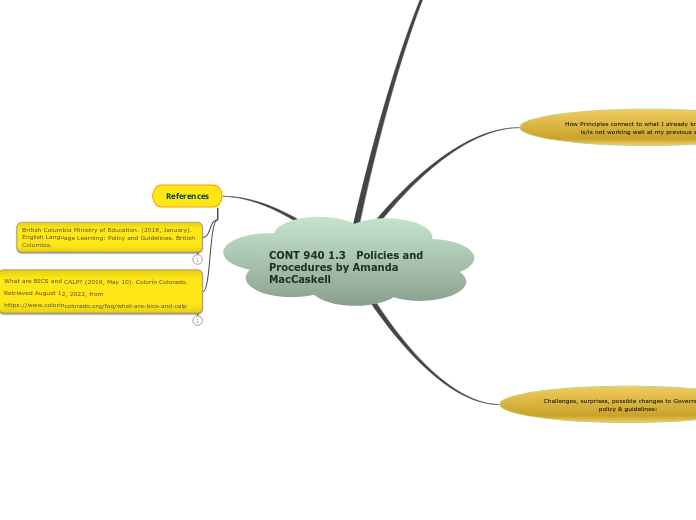CONT 940 1.3 Policies and Procedures by Amanda MacCaskell
Policy and Guidelines in my setting
Parameters for services and flexibility of delivery (4).
Teachers need to be connecting, checking in and reviewing student progress
Meet needs of students and follow their needs, based on assessment and observations, with 5 year government funding in mind, DEFINITELY keep accurate and current data collection
"Orientation to societies and cultures of BC" (4).
Celebrate Indigenous Culture through literature, story, professional development, and whole school art enrichment activities
Celebrate holidays like Halloween, Diwali, and other cultural identities
Support refugee families and students along with other ELLs both immigrant and Canadian born
Board of Education
Funding given, Policies and Guidelines given
District
Allocate funding
Have specialized staff available (ELL specialists, Settlement workers, critical care counsellors)
School Level
Access resources and advocate for students
Communication between school team, family and student
How Principles connect to what I already know & what is/is not working well at my previous school:
Key connection to what I know
Connect to student backgrounds to build competent and confident young people, in order to become functioning and economically independent members of society
Families and parent involvement are key (6)
What is working well: Differentiation - Know your learners, family communities
Care ABOUT students, their SEL and academic success & families (WITS program, Family Friday Reading, school wide digital assemblies, Facebook page, Secret Reader, multi-cultural texts in library)
Capitalize on L1 and differentiate instruction and lessons to integrate all ELL's
Stretches for the school: That ELL CALP (Cognitive Academic Language Proficiency) development does not necessarily match BICS (Basic Interpersonal Communicative Skills) and represent student culture in daily learning
Collaboration with peers & cooperative learning opportunities to practice CALP in lower risk situations, graphic organizers to support academic language development across curriculum
How can we show more respect and value towards individuals' first language and culture?
Challenges, surprises, possible changes to Government policy & guidelines:
1 Challenges
Effective Special needs and ELL programming in Elementary (consistent across all environments) alongside government funding for students with special needs who don't have a formal diagnosis, or are in the process of accessing services at Sunnyhill, Children's Hospital etc.
Effective access to trauma counsellors for Refugee students and SLIFE's
Translators, technology (text to voice, or voice to voice translators for instance), available to families with another L1 at any time to remove barriers to communicating with the school and staff and maintain family dignity.
2 Suprises
Assessment of student first language suggested as a possibility in the BC Guidelines. Resources are not available for this
Ministry of Education "monitors student performance and reports the results to the public" (17). Where is this information reported? Does the public have the BICS and CALP learning processes and different stages of language acquisition explained to them, to understand ELL performance?
“Research from Collier and Thomas (1995) has shown that it may take children with no prior instruction or no support in native language development at least seven years to develop CALP.” What are BICS and CALP? (2019, May 10). Colorín Colorado. Retrieved August 12, 2022, from https://www.colorincolorado.org/faq/what-are-bics-and-calp
3 Possible additions to Government Policies
Data and assessments are inputted into MyEd for teachers to access right away in September (like a digital ELL report card with student writing, reading level and comprehension level work samples)
Refugees and SLIFE's (students with limited or interrupted formal education) are considered a totally different category of ELL and have access to extra supports and resources throughout entire schooling
References
British Columbia Ministry of Education. (2018, January). English Language Learning: Policy and Guidelines. British Columbia.
What are BICS and CALP? (2019, May 10). Colorín Colorado. Retrieved August 12, 2022, from https://www.colorincolorado.org/faq/what-are-bics-and-calp
